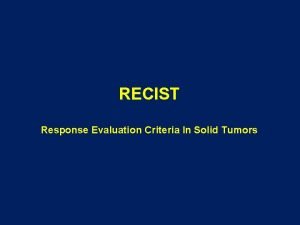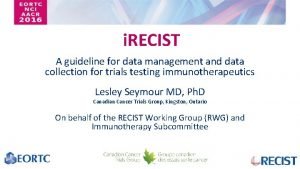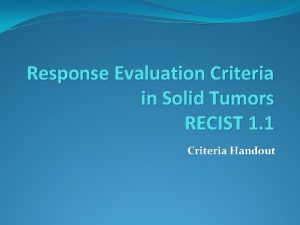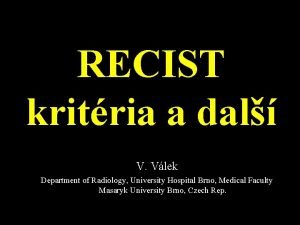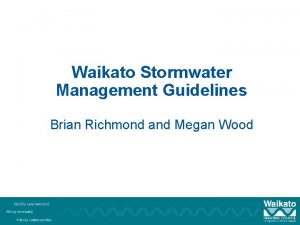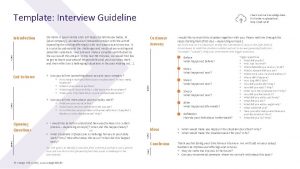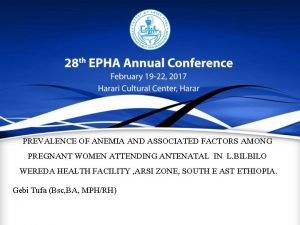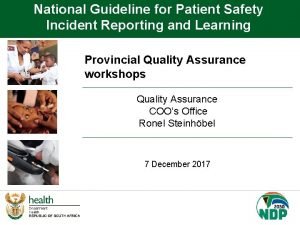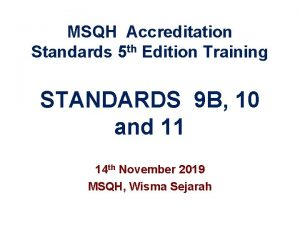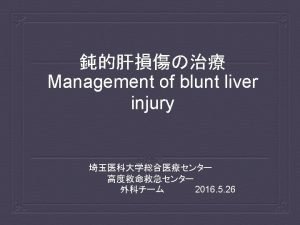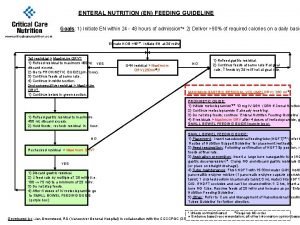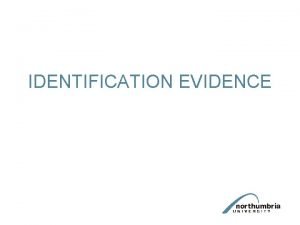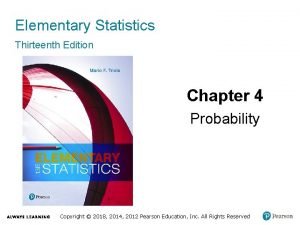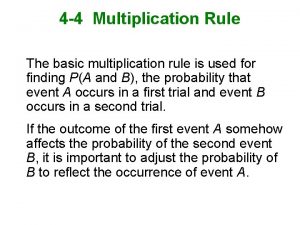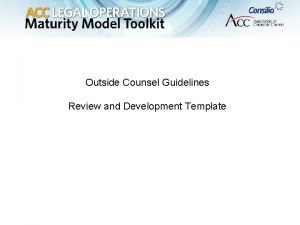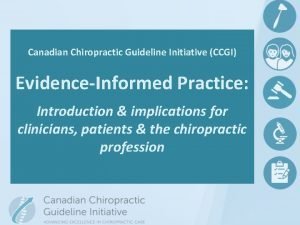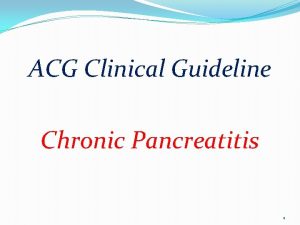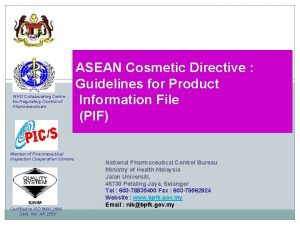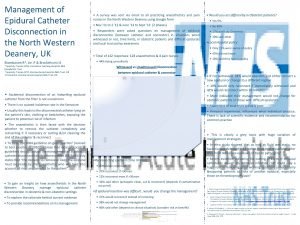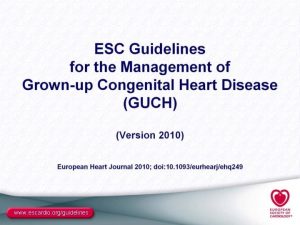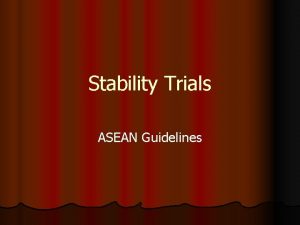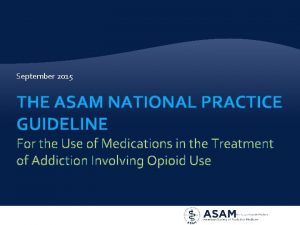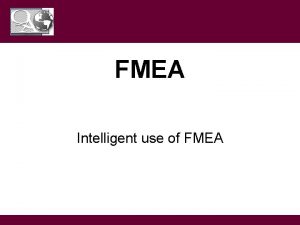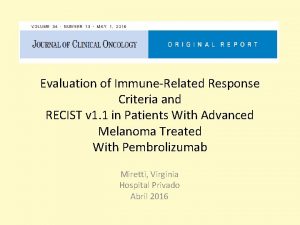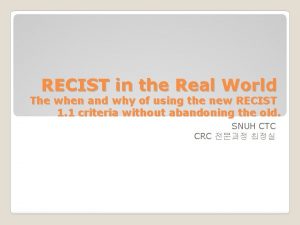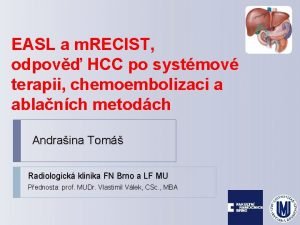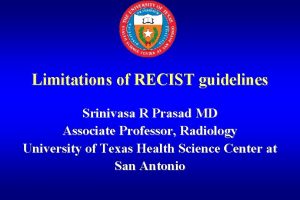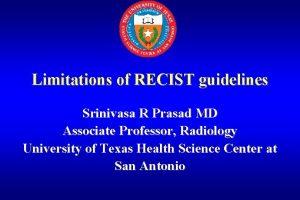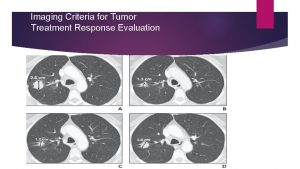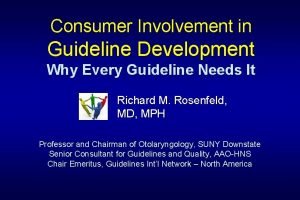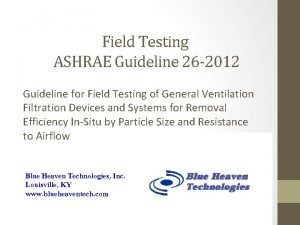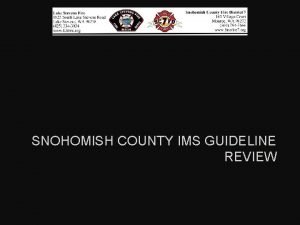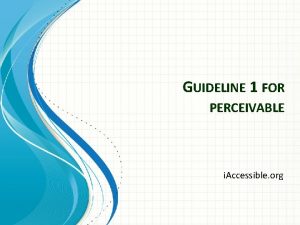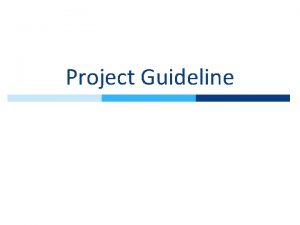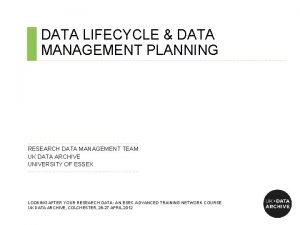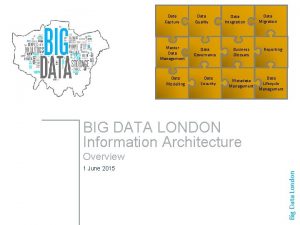i RECIST A guideline for data management and









































- Slides: 41

i. RECIST A guideline for data management and data collection for trials testing immunotherapeutics Lesley Seymour MD, Ph. D Canadian Cancer Trials Group, Kingston, Ontario On behalf of the RECIST Working Group (RWG) and Immunotherapy Subcommittee

Disclosures I have no conflicts to declare

Response and Immunotherapy • We know – Progression based endpoints are increasingly used for marketing approvals – Immune based therapies are a major advancement in patient care – Unusual response patterns well described especially in melanoma • We don’t know – True frequency – Optimal response criteria or how to implement them

Unusual Response Patterns TP 3 Baseline Time point 2 TP 3

How should we assess response and progression for trials of immunotherapies?

• • • RECIST Working Group Overview of current criteria & concerns Development of i. RECIST Overview of i. RECIST with examples Using i. RECIST in your trials

RECIST Working Group Unidimensional measures Create IPD Warehouse to Develop and Test Response Criteria RECIST (2000) Number of lesions to be measured, nodes? à RECIST 1. 1 (2009) Functional imaging Publish Revised Criteria In progress (if indicated) Targeted agents different? No change Identify Next Question Immunotherapy

Testing and Validating RECIST for Trials of Immunotherapy Initial plan (2012) : – Create a warehouse – Validate RECIST 1. 1 and / or publish new criteria • Became apparent there were multiple similar, but distinct, interpretations of immune response criteria

Response and Immunotherapy • ir. RC - consensus based recommendations (2009) – Based on WHO, bi-dimensional measures – New lesion measures included in sum of measures of target lesions • Subsequent modifications proposed – Based on RECIST/RECIST 1. 1 Wolchok JD, et al. Guidelines for the evaluation of immune therapy activity in solid tumors: immune-related response criteria. Clin Cancer Res. 2009; 15: 7412– 20. Nishino M et al Developing a common language for tumor response to immunotherapy: Immune-Related Response Criteria using unidimensional measurements. Clin Cancer Res. 2013; 19: 3936– 43. Bohnsack O et al. Adaptation of the immune-related response criteria: ir. RECIST. Ann Oncol 2014; 25 (suppl 4): iv 361–iv 372. Hodi FS et al. Evaluation of Immune-Related Response Criteria and RECIST v 1. 1 in patients with advanced melanoma treated with pembrolizumab. J Clin Oncol 2016; 34: 1510– 7. Chiou VL et al. Pseudoprogression and Immune-Related Response in Solid Tumors. J Clin Oncol 2015; 33: 3541– 3543.

Response Criteria RECIST 1. 1 ir. RC (+ unidimensional variant) “ir. RECIST /ir. RECIST 1. 1” variants Bi/unidimen. ? Unidimensional Bidimensional Unidimensional N Target 5 15; (≥ 5 × 5 mm) 10 / 5 (≥ 10 mm/ ≥ 10 mm (15 for nodes)) New target lesions added to sum or measures (SOM)? No (≥ 5 × 5 mm); Yes - does not automatically define PD (RECIST or RECIST 1. 1 rules) Yes How many ? NA 10 visceral, 5 cutaneous 10 / 5 (RECIST 1. 1 rules) Definition of progression (PD) ≥ 20% ↑ compared ≥ 25% ↑ compared to to nadir (≥ 5 mm ↑) baseline (BL), nadir/reset BL ≥ 20% ↑ compared to nadir (≥ 5 mm ↑) Confirmation ? No Yes, required Yes, recommended How confirmed? NA Not defined; not improved? Imager feels change is worse?

Testing and Validating RECIST for Trials of Immunotherapy Concerns – Multiple variations used across trials – Comparability – Response data /measures not always collected after RECIST defined progression – May not be applicable to other tumour types

True or Pseudoprogression ? 1 2 IF TRUE PROGRESSION THE START OF EFFECTIVE SALVAGE THERAPY DELAYED FOR MANY WEEKS

Testing and Validating RECIST for Trials of Immunotherapy Revised plan – Standardise data management and collection - develop consensus guidelines (termed i. RECIST) – Create IPD warehouse and validate criteria • If necessary publish updated RECIST (2? )

Development of i. RECIST Guideline Fall 2015 Initial meetings: RWG, pharma Agreement on plans Presentation and Publication Fall 2016 Wide review Spring 2016 F 2 F - ASCO: RWG, groups, pharma, regulatory – clinicians, imagers and statisticians Draft Manuscript Agreement on key principles Summer 2016 Draft White Paper Data collection ongoing and validation planned in the coming 1 -2 years

i. RECIST Addresses • Recommendations on – Terminology (“i” prefix) – Data to be collected after RECIST 1. 1 defined PD – Definition of “events” – Primary endpoints versus exploratory endpoints • They are not treatment decision guidelines • These are not (yet) validated response criteria • They are internationally agreed data recommendations from academia, pharma and regulatory authorities

i. RECIST vs RECIST 1. 1: Unchanged RECIST 1. 1 Definitions of measurable, non-measurable disease i. RECIST Definitions of target (T) and non target (NT) lesions Measurement and management of nodal disease √ √ Calculation of the sum of measurement (SOM) Definitions of CR, PR, SD and their duration Confirmation of CR and PR √ √ √ Definition of progression in T and NT (i. RECIST terms i-unconfirmed progression (i. UPD)) √ √

i. RECIST vs RECIST 1. 1: Changes RECIST 1. 1 i. RECIST Management of new lesions NEW Time point response after RECIST 1. 1 progression NEW Confirmation of progression required NEW Collection of reason why progression cannot be confirmed NEW Inclusion and recording of clinical status NEW

i. RECIST vs RECIST 1. 1: Changes • New lesions (NL) are assessed using RECIST 1. 1 principles – Up to 5 (2 per site) measured (NL-T) are included in i. SOM • Not included in SOM of target lesions identified at baseline – Other NLs (measurable/non-measurable) are recorded as non-target (NL-NT) • Time point (TP) response after RECIST 1. 1 PD. – Once a PD always a PD is no longer the case – First RECIST 1. 1 PD is “unconfirmed” - i. UPD Prior i. UPD does – i. UPD must be confirmed at the next assessment (4 -8 weeks) not preclude • TP response is dynamic and based on subsequent i. CR, – Change from baseline (i. CR, i. PR, i. SD) or change from nadir (PD) i. PR or i. SD – The last i-response

i. RECIST vs RECIST 1. 1: Changes • Treatment past PD should only be considered if patient clinically stable* – No worsening of performance status. – No clinically relevant ↑in disease related symptoms – No requirement for intensified management of disease related symptoms (analgesics, radiation, palliative care) • Record the reason i. UPD not confirmed – Not stable – Treatment stopped but patient not reassessed/imaging not performed – i. CPD never occurs * recommendation – may be protocol specific – Patient has died

Summary RECIST 1. 1 30 i. RECIST DESCRIBES DATA MANAGEMENT, COLLECTION AND USE PD i. UPD 20 10 0 Baseline TP 1 TP 2 TP 3 TP 4 TP 5 -10 i. SD -20 i. PR -30 -40 Target TREATMENT Non Target New lesion PD: i. SD: i. PR: i. UPD: TP: progression stable disease partial disease unconfirmed progression timepoint

Confirming Progression (i. CPD) i. UPD (T) ≥ 5 mm ↑ in SOM i. UPD (NT) Any ↑ Worsening in lesion category with prior i. UPD NLT ≥ 5 mm ↑ in i. SOM Disease Burden i. UPD (NLs) NLNT - Any increase OR i. UPD OR i. CPD New lesion ≥ 20 %↑ in NEW RECIST 1. 1 PD nadir SOM in lesion category without prior i. UPD UNE ↑ in NT

i. CPD in Lesion Category with i. UPD Target Next assessment ≥ 5 mm↑ i. CPD Non Target Unequiv. ↑ Any in size ↑ i. CPD New lesion NLT ≥ 5 mm↑ NLNT Any↑ Another NL i. CPD ≥ 20% ↑

New RECIST PD in another Lesion Category i. UPD Next assessment Non Target Uneq. ↑ Target ≥ 20↑ i. CPD OR Target ≥ 20% ↑ Non Target Uneq. ↑ New Lesion i. CPD Target ≥ 20% ↑ i. CPD

Notes: assigning PD in i. RECIST: • Must be the NEXT assessment – if i. SD, i. PR or i. CR intervenes then bar is reset and i. UPD must occur again and be confirmed. • Two ways to confirm – Existing i. UPD gets worse – “low bar” – Lesion category without prior i. UPD now meet RECIST 1. 1 criteria for PD • If confirmatory scans not done must document reason why

Summary RECIST 1. 1 i. RECIST DESCRIBES DATA MANAGEMENT, COLLECTION AND USE 30 PD 20 i. UPD 10 0 Baseline TP 1 TP 2 TP 3 TP 4 TP 5 -10 -20 i. SD i. PR -30 -40 Target TREATMENT Non Target New lesion PD: i. SD: i. PR: i. UPD: TP: progression stable disease partial disease unconfirmed progression timepoint

Confirming Progression (i. CPD) i. UPD (T) ≥ 5 mm ↑ in SOM i. UPD (NT) Any ↑ Worsening in lesion category with prior i. UPD NLT ≥ 5 mm ↑ in i. SOM Disease Burden i. UPD (NLs) NLNT - Any increase OR OR New lesion ≥ 20 %↑ in NEW RECIST 1. 1 PD nadir SOM in lesion category without prior i. UPD UNE ↑ in NT i. UPD i. CPD

Summary RECIST 1. 1 i. RECIST DESCRIBES DATA MANAGEMENT, COLLECTION AND USE 30 PD i. CPD i. UPD 20 10 0 Baseline TP 1 TP 2 TP 3 TP 4 -10 i. SD -20 i. PR -30 -40 Target TREATMENT Non Target New lesion TP 5 TP 6

i. CPD: Target PD followed by ≥ 5 mm↑ Baseline TP 1: • ≥ 20% ↑ in SOM = PD by RECIST 1. 1 • i. UPD by i. RECIST • Clinically stable TP 2 (4 wks later): • SOM ↑ ≥ 5 mm above i. UPD • i. CPD

i. CPD: NL then ≥ 5 mm ↑i. SOM Baseline: Target - para aortic mass TP 1: • T lesion stable ; • New node = PD / i. UPD • Clinically stable. TP 2 (+ 4 w): • T stable, • NLT ↑ ≥ 5 mm • i. CPD

i. CPD: NL then additional NL Baseline: T - liver TP 1: • New Lesion • PD / i. UPD • Clinically stable. TP 2 (+ 4 w) • TL and NLT no change • Additional NL • i. CPD No change from ir. RECIST

Statistical Considerations • RECIST 1. 1 should remain primary criteria – i. RECIST exploratory • i. RECIST Event (progression) – i. UPD date which has been subsequently confirmed – If i. UPD never confirmed • If a subsequent i. SD, i. PR or i. CR is seen with no later i. UPD or i. CPD then the initial i. UPD is ignored • Otherwise the i. UPD date is used – Patient not considered to be clinically stable, stops protocol treatment and no further response assessments are done – The next TPRs are all i. UPD, and i. CPD never occurs. – The patient dies of cancer

Data Collection • Investigator/site assessment is the primary method of evaluation for RECIST and i. RECIST in keeping with RWG principles • Record time-point and best overall response for both – RECIST 1. 1 – i. RECIST • Record reasons – Treatment discontinued when i. UPD – i. CPD not confirmed • Independent imaging review can occur in parallel if indicated

i. RECIST in a Nutshell • RECIST 1. 1 – primary criteria • Progression must be confirmed – Consider treatment past progression only in carefully defined scenarios – Confirmation requires some worsening of disease bulk • New lesions – Managed using RECIST 1. 1 principles – NOT added to SOM (but included in separate i. SOM) • Unconfirmed progression does not preclude a later iresponse

Conclusions • Recommendations on terminology, collection and response definitions for trials including immunotherapeutics • They are not recommendations for treatment decisions – How to manage the clinical trial data if treatment is continued past RECIST 1. 1 progression • RECIST 1. 1 should continue to be used to define response based endpoints for late stage trials planned for marketing authorisations • Data collection for testing and validation is ongoing – May result in a formal update to RECIST • The RWG is always happy to address any questions http: //www. eortc. org/recist/contact-us/

RECIST Working Group http: //www. eortc. org/recist/contact-us/

References and Resources In Press http: //www. eortc. org/recist • This presentation • Protocol sections • CRF examples • FAQ • A WORD version of the manuscript (after publication)

Acknowledgments Institution/Agency RECIST Working Group Participants Elisabeth de Vries, Jan Bogaerts, Saskia Litière, Alice Chen, Robert Ford, Sumithra Mandrekar, Nancy Lin, Janet Dancey, Lesley Seymour, Stephen Hodi, Larry Schwartz, Patrick Therasse, Eric Huang, Otto Hoekstra, Lalitha Shankar, Jedd Wolchok, Yan Liu, Stephen Gwyther European Medicines Agency Food and Drug Agency, USA Astra. Zeneca Francesco Pignatti, Sigrid Klaar, Jorge Martinalbo Patricia Keegan, Sirisha Mushti, Gideon Blumenthal Ted Pellas, Ramy Ibrahim**, Rob Iannone, Renee Iacona Merck Andrea Perrone*, Eric Rubin, Roy Baynes, Roger Dansey Bristol Myers Squibb Genentech David Leung, Wendy Hayes* Marcus Ballinger, Daniel S Chen, Benjamin Lyons, Alex de Crispigny Gustave Roussy Cancer Campus Caroline Caramella Amgen Roger Sidhu * RECIST Working Group Member ** Currently Parker Institute

Acknowledgements We also received written comments from: Darragh Halpenny, Jean-Yves Blay, Florian Lordick, Silke Gillessen, Hirokazu Watanabe, Jose Pablo Maroto Rey, Pietro Quaglino, Howard Kaufman, Denis Lacombe, Corneel Coens, Catherine Fortpied, Jessica Menis, Francisco Vera. Badillo, Jean Powers, Michail Ignatiadis, Eric Gauthier, Michael O’Neal, Caroline Malhaire, Laure Fournier, Glen Laird. Supported by • Canadian Cancer Society Research Institute (grant #021039) • EORTC Cancer Research Fund • NCI (grant number 5 U 10 -CA 11488 -45)

Back up slides

Summary: RECIST 1. 1 vs. i. RECIST 1. 1 i. RECIST Measurable lesions are ≥ 10 mm in long diameter Definitions of No change; however, (15 mm for nodal lesions); measurable and non • NEW lesions assessed per RECIST 1. 1 maximum of 5 lesions (2 per measurable disease; • Recorded separately on the CRF organ); all other disease numbers and site of • NOT included in the SOM for target lesions considered not-target (must be target disease identified at baseline 10 mm of longer in short axis for nodal disease) CR, PR or SD Cannot have met criteria for PD prior to CR, PR or SD May have had i. UPD (1 or more instances), but not i. CPD, prior to i. CR, i. PR or i. SD Confirmation of CR, PR Only required for nonrandomized trials As per RECIST 1. 1 Confirmation of SD Not required As per RECIST 1. 1

Summary: RECIST 1. 1 vs i. RECIST New lesions RECIST 1. 1 i. RECIST Results in PD. Recorded but not measured Results in i. UPD but i. CPD is only assigned based on this category if at next assessment Additional NL appear or Increase in size of NLs (≥ 5 mm for SOM of NLT or any increase in NLNT) Remember NLs can also confirm i. CPD if i. UPD was only in T or NT disease Independent blinded Recommended in some Collection of scans (but not independent review) review and central circumstances recommended for all trials collection of scans Confirmation of PD Not required (unless equivocal) Always required Consideration of clinical status Not included in assessment Clinical stability is always considered and collected on case record form
 Recist kriterien
Recist kriterien Irecist calculator
Irecist calculator Response evaluation criteria in solid tumors (recist)
Response evaluation criteria in solid tumors (recist) Recist
Recist Waikato stormwater management guideline
Waikato stormwater management guideline Interview guideline template
Interview guideline template Anemia in pregnancy guideline
Anemia in pregnancy guideline Guideline anamnesa
Guideline anamnesa Patient safety incident policy
Patient safety incident policy Msqh standard
Msqh standard Guideline anamnesa
Guideline anamnesa East practice management guidelines
East practice management guidelines Enteral feeding guideline
Enteral feeding guideline Chapter 16 review questions milady
Chapter 16 review questions milady What is a guideline for hoisting a hoseline?
What is a guideline for hoisting a hoseline? What are the turnbull guidelines
What are the turnbull guidelines 5% guideline for cumbersome calculations
5% guideline for cumbersome calculations 5% guideline for cumbersome calculations
5% guideline for cumbersome calculations Who guideline on country pharmaceutical pricing policies
Who guideline on country pharmaceutical pricing policies Sample outside counsel guidelines
Sample outside counsel guidelines Ccgi guidelines
Ccgi guidelines Chronic pancreatitis guideline
Chronic pancreatitis guideline Bpfk cosmetic guideline
Bpfk cosmetic guideline Guideline clinical nutrition in patients with stroke
Guideline clinical nutrition in patients with stroke Disconnected epidural catheter guideline
Disconnected epidural catheter guideline Escardio
Escardio Asean stability guideline
Asean stability guideline Asam national practice guideline
Asam national practice guideline Srm process flow
Srm process flow Kdigo 2012 clinical practice guideline
Kdigo 2012 clinical practice guideline Fmea guideline
Fmea guideline Hrayr shahinian
Hrayr shahinian Kontinuitetshantering
Kontinuitetshantering Typiska novell drag
Typiska novell drag Tack för att ni lyssnade bild
Tack för att ni lyssnade bild Returpilarna
Returpilarna Varför kallas perioden 1918-1939 för mellankrigstiden?
Varför kallas perioden 1918-1939 för mellankrigstiden? En lathund för arbete med kontinuitetshantering
En lathund för arbete med kontinuitetshantering Kassaregister ideell förening
Kassaregister ideell förening Tidbok för yrkesförare
Tidbok för yrkesförare A gastrica
A gastrica Förklara densitet för barn
Förklara densitet för barn
